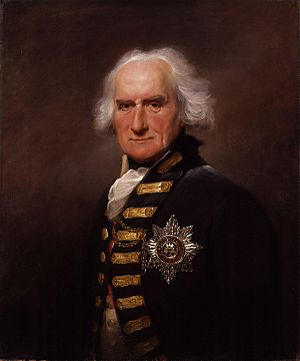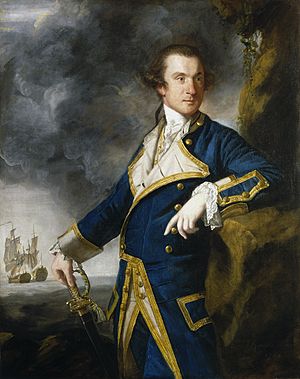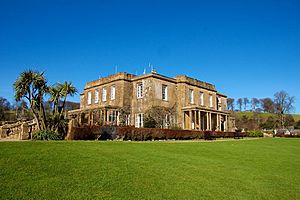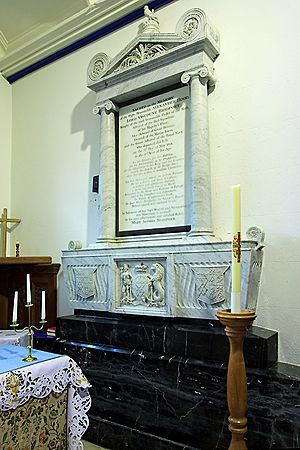Alexander Hood, 1st Viscount Bridport facts for kids
Quick facts for kids
The Viscount Bridport
|
|
|---|---|

Lord Bridport
|
|
| Born | 2 December 1726 |
| Died | 2 May 1814 (aged 87) |
| Allegiance | Great Britain |
| Service/ |
Royal Navy |
| Years of service | 1741–1800 |
| Rank | Admiral |
| Commands held | HMS Prince HMS Minerva HMS Africa HMS Robust Channel Fleet |
| Battles/wars | Seven Years' War American Revolutionary War French Revolutionary Wars |
| Awards | Knight of the Order of the Bath Large Naval Gold Medal |
Admiral Alexander Hood, 1st Viscount Bridport (2 December 1726 – 2 May 1814) was a brave officer in the British Royal Navy. He served during important conflicts like the French Revolutionary Wars.
Contents
Who Was Alexander Hood?
Alexander Hood was born in 1726. His father was Samuel Hood, a vicar (a type of priest) in Somerset.
Alexander had an older brother, Samuel Hood, 1st Viscount Hood, who also became a famous admiral. Several other family members also served in the Royal Navy.
Alexander Hood's journey into the navy began in an unusual way. A naval officer named Thomas Smith had his carriage break down in Alexander's village. Alexander's father invited Smith to stay at their home.
During his stay, Smith offered to take one of the Hood sons to sea. Alexander's older brother, Samuel, first said no. But Alexander eagerly accepted the offer.
About a year later, Alexander returned home. He told his brother Samuel such exciting stories that Samuel also decided to join the navy. Both brothers went on to become important admirals.
Alexander officially joined the navy in January 1741. By 1746, he became a lieutenant. He was promoted to commander in 1756.
Seven Years' War (1756–1763)
During the Seven Years' War, Alexander Hood fought in the Battle of Quiberon Bay in 1759. He was captain of a ship called HMS Minerva.
In 1761, his ship Minerva bravely recaptured Warwick. This British ship had been taken by the French a few years earlier. Hood fought a long battle to get it back.
After this, he commanded HMS Africa in the Mediterranean Sea until 1763.
American War of Independence (1775–1783)
Hood continued to serve actively in the navy. In 1778, he commanded HMS Robust at the First Battle of Ushant.
In 1780, he was promoted to Rear Admiral of the White. He helped Admiral Howe in 1782 to relieve Gibraltar, which was under siege.
French Revolutionary War (1792–1802)
In 1787, Hood became a vice-admiral. He was also made a Knight of the Order of the Bath in 1788.
When war with France began in 1793, he returned to sea. On June 1, 1794, he was third in command at the famous battle known as the Glorious First of June. For his bravery in this battle, he was given the title of Baron Bridport. He also received a special Naval Gold Medal.
Battle of Groix
On June 23, 1795, Hood led his fleet in the Battle of Groix. He fought against the French fleet off the coast of France. His forces captured three French ships.
Some people in the navy felt he could have won a bigger victory. However, the British public saw it as a great success. His title was then changed to an English peerage, and he was promoted to Vice-Admiral of Great Britain.
Commander of the Channel Fleet
From 1795 until his retirement in 1800, Hood was the commander of the Channel Fleet. This was a very important role, as this fleet protected Britain's waters.
In 1797, a major event happened: the Spithead fleet mutiny. Sailors protested their pay and conditions. Hood tried to calm his own ship's crew, but the mutiny spread. It took a lot of effort to restore order.
After the mutiny, Hood led the fleet to sea. From 1798, he personally managed the blockade of Brest, a key French port. This blockade became very strict.
In 1800, he retired from the navy. As a reward for his long and excellent service, his title was raised to a viscounty. He spent the rest of his life in retirement. He passed away on May 2, 1814.
Cricket House
In 1786, Admiral Hood built a beautiful Georgian manor house called "Cricket House." It was designed by his friend, the famous architect Sir John Soane.
Hood had bought the land in 1775. The house is still standing today and is a grade II listed building.
His Marriages
Alexander Hood married twice but did not have any children.
- His first wife was Maria West. She passed away in 1786.
- His second wife was Mary Sophia Bray. They married in 1788.
Death and Legacy
Alexander Hood died on May 2, 1814. Since he had no children, his viscountcy (his highest title) ended.
His other title, the Irish barony, passed to his great-nephew, Samuel Hood, 2nd Baron Bridport. Samuel was married to Charlotte Mary Nelson, who was related to the famous Admiral Horatio Nelson.
Alexander Hood was buried in Cricket St Thomas Church. A monument designed by his friend Sir John Soane stands there. It praises his bravery, his skills, and his loyalty to his country. It also mentions his kindness, his generosity to those in need, and how much he was loved.
See also
- Hood's cousin once removed, also named Alexander Hood (1758–1798), was a captain in the Royal Navy, famous for a duel between his ship Mars and the French Hercule.





